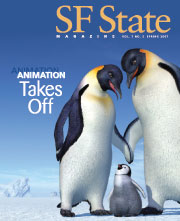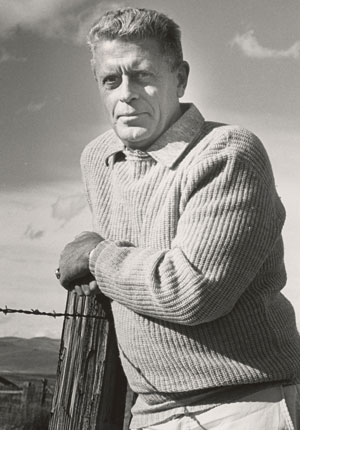 |  | |||
When he joined the faculty of San Francisco State College, Walter Van Tilburg Clark was one of the most famous novelists in the country. His best-known work, "The Ox-Bow Incident," redefined the Western genre by avoiding the heroic lone horseman, roundups, shootouts, burning arrows and sexy saloon girls. Instead, the novel was realistic and gritty, turning the Western myth upside down by chronicling the mob lynching of innocent men while the cowboy narrator just stands by. Clark was invited to teach at SF State's writer's workshop the summer of 1955. He had heard the College had the kind of close ties to local high schools and junior colleges that he had always advocated. "And," he wrote to his Random House editor Saxe Commins, "of all cities, San Francisco is the only one I love." During the course of the workshop, he was hired on a full-time basis to establish a formal Creative Writing Program. Through this program, SF State went on to hire many prominent writers, including Mark Harris, Kay Boyle and Wright Morris, and became one of the leading centers of creative writing instruction in the country. Charles Brashear, (attended, '60-'61), novelist and editor, recalled his classes with Clark: "We were a pack of graduate students at San Francisco State in the late '50s and early '60s, wolfing up Walter's classes. In analyzing a piece of fiction or in drawing our insights into the creative act, he was superb ⦠He could get a discussion, an honest-to-God discussion, going in a group of 60 or more students. We often marveled at that ⦠Reading all that written work must have been gargantuan. I still have an essay I wrote for Walter in one of those classes ⦠he wrote a comment on it, 1,500 words long." One of John Christgau's (B.A., '58; M.A. '61) most distinct memories is of Clark's handwriting. "He would write in blue pencil that must have had a point on it like a carpenter's pencil ⦠a broad pencil tip so that the writing was flat and very small and almost completely unreadable." Students would gather together in the hallway to try to decipher the comments, which led to many friendships. "If you did not know that buried in that inscrutable writing there was enormous technical wisdom about story writing, you would have let it go," Christgau recalled. "But he was so thoughtful in his remarks and he took such time with each student and story." The late Irving Halperin was just beginning his own teaching career when he asked Clark, "How do I reach students? How do I reach them so that they can experience the feeling of having learned something worthwhile?" Clark talked with him and later sent a letter in which he tried to answer Halperin's questions. "I feel sure the best happens between teacher and student not by means of the direct attack, but only indirectly, by way of the âthing between,' the poem, story, what-have-you. A mutual concentration coming as close to self-forgetfulness as possible ⦠I know more of my friend from watching him watch a bird flying than from looking into his eyes. I will know still more if we both watch the bird flying, and then take the same length of time to begin moving again when the bird has vanished." Clark's influence was not limited to the classroom. In the summer of 1957, when the city of San Francisco prosecuted Lawrence Ferlinghetti on the charge of disseminating obscenity by publishing Allen Ginsberg's "Howl and Other Poems," Clark, along with several other SF State professors, testified for the defense. He did not particularly care for the Beat poets but he felt the case was a matter of freedom of expression. Clark soon found he missed Nevada, where he had once lived, the desert, its heat and dryness and the Western legends. In early 1962 when he received an offer to teach at the University of Nevada, he took it. His friends and colleagues at SF State were sorry to lose him. He had enlivened the department and made an indelible impression on hundreds of incipient writers. When Clark died in 1971, Halperin was among those who traveled to his funeral in Virginia City. "At the precise moment, when my own feelings were beginning to show as too nakedly human, too visible and self-involved, there came, through a break in the clearing sky and over the ridge of a nearby hill, a flock of intervening birds. I looked up and watched them ⦠They made a beautiful swoop, and then departed, and left behind them, for me, a vast and meaningful silence." Jackson J. Benson(M.A., '56) is the author of "The Ox-Bow Man: A Biography of Walter Van Tilburg Clark (University of Nevada Press, '06). | ||||









